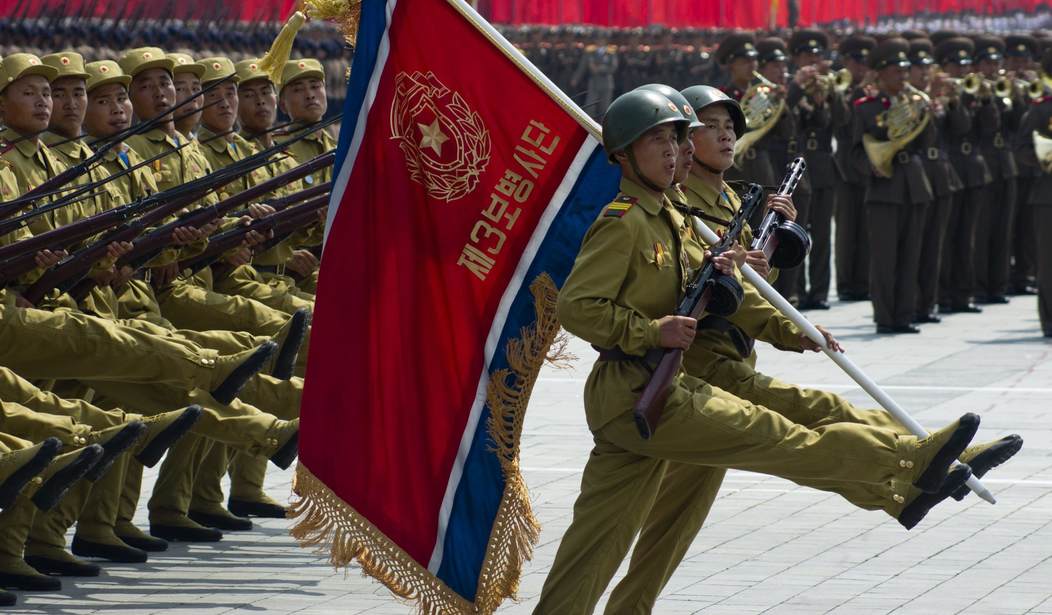Constantly threatening neighbors with nukes has been the Kim family method of being a big man on the block for decades. For a dynasty living in a shack palace in a rich neighborhood, North Korea’s Kim Jong Un has done OK, receiving aid from those he’s menaced and Kim feared (he would say “respected”) even by those with no conceivable reason for fearing him. Economic giants like China, Japan and South Korea hang on his every word.
Yet without the ability to twirl a nuclear gun around his finger Kim would be a punk nobody. The constant problem for Kim is how to keep skirting the edge without falling off it. Now he may have slipped up. Secretary of state Rex Tillerson has announced Kim that since “diplomatic and other efforts” had proved useless it was time for a “new approach”.
Speaking to reporters in Tokyo after talks with Japan’s foreign minister, Fumio Kishida, Mr. Tillerson said, “The diplomatic and other efforts of the past 20 years to bring North Korea to a point of denuclearization have failed,” noting that during those 20 years, the United States had provided $1.35 billion in assistance to North Korea to encourage it to abandon its nuclear program.
“Part of the purpose of my visit to the region is to exchange views on a new approach,” Mr. Tillerson added, saying he would highlight the issue in Seoul, the South Korean capital, and Beijing, the next stops on his trip.
Tillerson did not say what such a new approach would be except to rule nothing out. But since open source studies have long mapped out all the conceivable alternatives it is not too hard to make a reasonable guess what it will be. The main alternatives to diplomacy are to 1) undertake kinetic military action and/or 2) expand and strengthen allied defenses. Kinetic military action is out. Trump’s own campaign promises and the inherent riskiness of war make it unlikely except as a response to an actual North Korean attack.
That leaves a program of expanding Japanese and Korean defenses as the most probable “new approach”. This will probably take the form of creating an integrated missile defense network over the northern Pacific. It would suit the Department of Defense‘s book which has long identified the need for a shield against threats from the West and East — North Korea and Iran. It would be relatively simple for Trump administration to ramp up the construction of the missile shield with the co-operation of Japan and South Korea, countries with immense technological and industrial resources.
Presently, sophisticated ballistic missile technology is available on a wider scale than ever to countries hostile to the U.S. and our allies … Iran’s ballistic missiles are capable of striking targets throughout the region, ranging as far as southeastern Europe. Iran is likely to continue developing more sophisticated missiles, with improved accuracy, range and lethality. …
North Korea has expanded the size and sophistication of its ballistic missile forces — from close-range ballistic missiles to ICBMs — and has conducted an unprecedented level of nuclear tests and ballistic missile launches since 2016, including its fourth and fifth nuclear tests, as well as its short-range, medium-range, intermediate-range, long-range, and submarine-launched ballistic missile (SLBM) launches. In February 2016, Pyongyang launched a TD-2 SLV from a west coast testing facility. The technology involved in a satellite launch would be applicable to North Korea’s other long-range missile programs. In addition to the Taepo Dong 2 SLV/ICBM, North Korea is developing and has paraded the two road-mobile ICBMs which, if successfully developed, would likely be capable of reaching much of the continental United States.
Buying more Aegis missile defense ships for the Navy, building more tracking systems and selling equipment to the Japanese and Koreans might raise objections among Democrats, but not all since it would attract substantial support among defense contractors and Washington lobbyists. As a strategy it is domestically viable. Most importantly it would be effective. Missile defense would greatly reduce North Korean confidence any attack would succeed.
Pyongyang currently has two development platforms for an ICBM missile delivery system: a road mobile solid fuel rocket and a possible conversion of its gantry supported satellite launching system, all tested in nearby waters due to the lack of long range tracking facilities. Increasing the sophistication of Pacific defense systems in combination with the slow pace of Nokor missile development (in comparison to equivalent US and Soviet efforts in the ’50s) might raise the bar faster than North Korea can increase the height of its jump.
But improving defenses would also have the side effect of provoking China. That is the chief danger. Beijing can hardly be expected to watch with arms folded as Japanese and South Korean defenses improve in capability and sophistication. Tillerson recognized this and challenged China to rein in North Korea to forestall a Japanese and South Korean buildup. The Kim family is becoming an increasing liability for China which may one day decide they are more trouble than they are worth.
Although no one can say until it is tried, a policy of expanding and strengthening allied defenses might well succeed where pure diplomacy has failed. Perhaps the greatest danger is it will actually work. No one is really prepared for that. The collapse of North Korea has been a real possibility for years and no one can predict how close Pyongyang is to falling off the cliff. What is a certain is if Pyongyang collapses a flood of millions of starving refugees will headed either across the Yalu to China in search of food or over the DMZ toward the lights of Seoul.
In and amid the chaos and ruin Kim’s stockpile of nuclear weapons might go missing, desperately sought by the special forces of South Korea, Japan, China, Russia and the United States. It would be a great movie, similar to World War Z with nuclear weapons thrown in but it’s a movie no one would want to watch in real life.
A 2015 study from the U.S.-Korea Institute at Johns Hopkins University’s School of Advanced International Studies estimated North Korea possessed 10 to 16 nuclear weapons, and will possess 20 to 100 such weapons by 2020. This says nothing of the highly enriched nuclear fuel the state has produced or the mobile rockets and longer-range missiles to launch the warheads.
Trying to secure all this after a chaotic collapse or overthrow of the Kim regime would be a nightmare. General Raymond Thomas, who heads U.S. Special Operations Command, called a regime collapse in North Korea a “worst case scenario,” at a conference hosted last week by the Institute for the Study of War. “In the event of the implosion of the region, we’d have the loose nuke dilemma on an industrial scale,” the general said, describing it as a “vertical track meet between the Chinese and the South Koreans in terms of securing the nukes.”
Faced with this scenario cynic might argue the world is better off having North Korea collapse now while it only has about a dozen nukes than waiting until 2020 when the number will be nearer a hundred. North Korea is an example of what happens when a can has been kicked down the road for more than 60 years and finally has nowhere left to go.
Follow Wretchard on Twitter
For a list of books most frequently purchased by readers, visit my homepage.
Support the Belmont Club by purchasing from Amazon through the links below.
Books:
The Vegetarian Flavor Bible: The Essential Guide to Culinary Creativity with Vegetables, Fruits, Grains, Legumes, Nuts, Seeds, and More, Based on the Wisdom of Leading American Chefs, by Karen Page. A comprehensive guide to maximizing flavor using vegetables based on insights from the chefs of such acclaimed restaurants as Crossroads and M.A.K.E. in Los Angeles; Cavendle 79, Dirt Candy, and Kajitsu in New York City; Green Zebra in Chicago; Greens and Millennium in San Francisco; Natural Selection and Portobello in Portland; Plum Bistro in Seattle; and Vedge in Philadelphia.
Inventing the Individual: The Origins of Western Liberalism, In a grand narrative spanning 1,800 years of European history, distinguished political philosopher Larry Siedentop firmly rejects Western liberalism’s usual account of itself as emerging in opposition to religion in the early modern era. He argues instead that liberal thought is, in its underlying assumptions, the offspring of the Church.
The Ransom of the Soul: Afterlife and Wealth in Early Western Christianity, by Peter Brown. Marking a departure in our understanding of Christian views of the afterlife from 250 to 650 CE, this much-acclaimed book explores a revolutionary shift in thinking about the fate of the soul that occurred around the time of the fall of Rome. Brown describes how this shift transformed the Church’s institutional relationship to money and set the stage for its domination of medieval society in the West. Some critics’ notes: “beautifully written” and “prodigiously original”.
The Day of Battle: The War in Sicily and Italy, 1943-1944 (Volume Two of The Liberation Trilogy), by Rick Atkinson. In the second volume of his epic trilogy about the liberation of Europe in World War II, Atkinson tells the harrowing story of the campaigns in Sicily and Italy. He follows the strengthening American and British armies as they invade Sicily in July 1943 and then, mile by bloody mile, fight their way north toward Rome.
For a list of books most frequently purchased by readers, visit my homepage.
Did you know that you can purchase some of these books and pamphlets by Richard Fernandez and share them with your friends? They will receive a link in their email and it will automatically give them access to a Kindle reader on their smartphone, computer or even as a web-readable document.
The War of the Words, Understanding the crisis of the early 21st century in terms of information corruption in the financial, security and political spheres
Rebranding Christianity, or why the truth shall make you free
The Three Conjectures, reflections on terrorism and the nuclear age
Storming the Castle, why government should get small
No Way In at Amazon Kindle. Fiction. A flight into peril, flashbacks to underground action.
Storm Over the South China Sea, how China is restarting history in the Pacific
Tip Jar or Subscribe or Unsubscribe to the Belmont Club










Join the conversation as a VIP Member